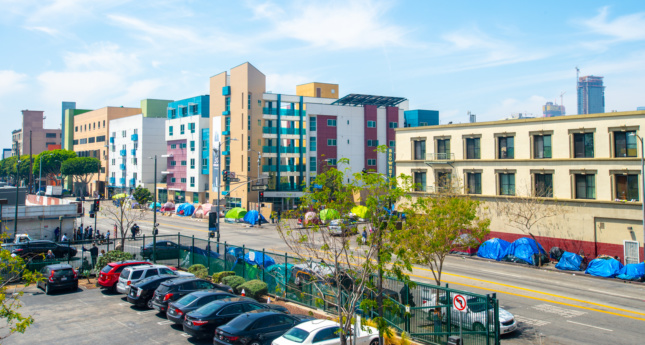With a pandemic sweeping across many of America’s largest population centers, phrases like “shelter-in-place,” “self-quarantine,” “stay at home” “social distancing,” and “hand sanitizer shortage” have become fundamental parts of our shared daily language. Yet for thousands of Americans, particularly in cities experiencing high levels of homelessness, these phrases are largely meaningless. For those living on the streets and in shelters, taking refuge from a deadly and highly contagious virus that requires the population to practice vigilance by isolating themselves indoors is, simply, impossible. As reported by Reuters, California Governor Gavin Newsom has warned that up to 60,000 homeless Californians could fall ill with the coronavirus (COVID-19) in the coming weeks.
A sharp influx of unsheltered people infected with the virus could put further strain on California’s hospitals as medical workers grapple to care for other vulnerable segments of the population including the elderly and those with preexisting conditions.
“Over the next eight-week period, we have modeled that of the 108,000 unsheltered Californians that are out on the streets, if you had an attack rate of about 56 percent, you’re looking at 60-plus thousand individuals that may have COVID-19,” said Newsom in a Facebook-streamed statement. “That creates a deep point of anxiety for the existing population but moreover for our healthcare delivery system, our capacity to move people in and out of the shelters safely without contacting other people and putting them at risk as well.”
While much attention has been placed on the Seattle and greater Puget Sound region, where the virus first appeared stateside and where the fatality rate remains the highest, and on ultra-dense, hospital bed-strapped New York City, California has also been heavily affected by COVID-19. As of this writing, there are 906 confirmed cases in the state and 18 deaths. (Nationwide, there are 10,755 confirmed cases and 154 deaths.)

As health and emergency officials scramble to curb the spread of the virus and care for those already sickened by it, there are growing local efforts to specifically shield the unsheltered population. In Los Angeles, Reuters reports that Mayor Eric Garcetti has launched a sweeping effort to identify the most vulnerable—this includes the elderly and those with underlying health problems— of the city’s unhoused population and provide shelter to over 6,000 of them in 42 makeshift shelters set up in recreational centers spread across the city. Those who test positive for the virus would be isolated in emergency trailers. Per LAist, the move was activated through the Disaster Service Worker Program, which enables Garcetti to redeploy city employees to “combat a crisis, including to house the homeless.”
LAist also reported that the initiative, which will be paid for through a mix of state and federal funds, is being rolled out in phases, with over 1,300 beds expected to be set-up in 13 rec centers by the top of the week. The Red Cross is providing the beds and the city’s Homeless Services Authority will do the work in locating those in greatest need. A rule that previously stipulated that homeless people must dissemble their tents during the daylight hours has been scrapped to promote social distancing and slow the spread of the virus.
In moments of crisis, we have to respond with every possible resource. Today I activated the Disaster Service Worker program, so we can redeploy any @LACity employee necessary to combat the COVID-19 crisis and assist in efforts to house the homeless. https://t.co/7XDrK0zW5v
— Mayor Eric Garcetti (@MayorOfLA) March 19, 2020
Yahoo News reported that city officials are also mulling converting vacant motels and hotels to house homeless individuals as the outbreak spreads. “This is an immense undertaking logistically and it’s never been done this quickly in a city, anywhere,” said Garcetti in a statement. “If we don’t get folks off the street, they will become the main spreaders or among the main spreaders of COVID-19 and a threat to themselves.” To date, no unsheltered person in Los Angeles has tested positive for the coronavirus. Outside of Los Angeles, a homeless man in the Santa Clara Valley died earlier this week from COVID-19 in the first known instance of an unsheltered individual succumbing to the virus. There are, as of March 17, 138 cases in ultra-wealthy Santa Clara County and 297 across the greater San Francisco Bay Area.

San Jose, California’s third most populous city, has installed hand-washing stations, portable toilets, and showers near established homeless encampments to promote improved hygiene, as reported by Bay Area CBS affiliate KPIX. In the wake of the reported death, however, homeless advocates are urging officials to enact greater, more urgent measures a la Los Angeles. “We’re accelerating efforts to identify motels and other locations where we can move folks as soon as the testing indicates we need to get them out and away from others,” said San Jose Mayor Sam Liccardo in a statement. In San Francisco, plans to provide emergency shelters to its homeless population are also coming together. Trent Rhorer, head of the city’s Human Services Agency, is currently in the process of securing large facilities that could accommodate, in the words of the San Francisco Chronicle, “at least 3,500 people who are either unsheltered or who live in congregant settings where they have to share bathrooms and kitchens and cannot self-quarantine.”
Shuttered college campuses and churches are being considered by Rhorer and other city officials as are vacant hotels and motels. As the Chronicle reports, Rhorer has already secured 500 hotel rooms for the express purpose of housing the homeless. Across the Bay in Oakland, the state government has also secured two hotels with nearly 400 rooms between them in a bid to shield the unhoused from the virus. However, one not-so-insignificant issue remains: how does the city staff these temporary facilities with case managers, drug counselors, and other workers that would normally be on-hand at a non-ephemeral homeless shelter? Rhorer is confident that it can happen. “It’s not like just setting up an emergency shelter in an earthquake,” he told the Chronicle. “But we can do this. We don’t have a cash flow issue in this city, so we can move fast. You brace for the worst and hope for the best.”











